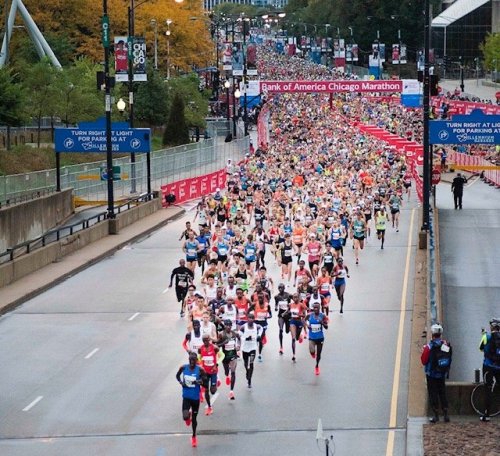This is a very good appraisal of the way pro marathon contracts are developed for the top road runners in the world. Understand that most of the athletes you see on a local level are lucky to get shoes, some travel and perhaps $250-$500 for a top 3 race performance.
The top athletes in the major events, like Abbott World Marathon Majors, see a much more lucrative financial offer. Events like London, Berlin, Boston, Chicago, New York and Tokyo have some of the best packages for athletes.
 The 2018 Bank of America Chicago Marathon, photo courtesy of Bank of America Chicago Marathon
The 2018 Bank of America Chicago Marathon, photo courtesy of Bank of America Chicago Marathon
And then, other races do things everywhere in between.
The Standard Chartered Dubai Marathon, gave little or no appearence fees, but a very robust performance and place bonuses. Some races offer lucrative travel packages, which allow athletes to train in warm weather with little or no costs.
David Monti helped demystify the way marathoners are compensated. And, of course, we use this piece from RRW with permission.
PRO MARATHON CONTRACTS EXPLAINED
By David Monti, @d9monti
(c) 2021 Race Results Weekly, all rights reserved, used with permission.
(07-Oct) — In advance of this weekend’s Abbott World Marathon Majors extravaganza featuring the Bank of America Chicago Marathon on Sunday and the Boston Marathon on Monday, Race Results Weekly would like to offer this “explainer” on how pro marathon contracts work and how elite marathoners actually get paid for competing in top races. Here are the basics:
Appearance & Promotional Fees:
The best athletes are paid a fee to participate in top marathons. Traditionally called appearance fees, this promise of payment from a race organizer, which occurs after the race has concluded, is used to recognize the value that an athlete brings to an event and to compensate them for the months of training they put in. It also compensates them for the competitions they are forced to miss while training (an athlete can’t run a fast 10-K during a high-mileage week of marathon training). Appearance fees can range from just a few thousand dollars, to over $200,000.
Appearance fees always come with conditions. For instance, athletes are often required to do a certain number of media appearances, both before and after the race, and they may be asked to do a certain number of social media postings to promote their participation. Moreover, they are typically asked to cooperate with race organizers on how and when their participation in the race is to be announced. Sometimes those media plans can be elaborate if it is a truly top star.
The most important condition, however, is the cut clause. Usually, athletes must meet some kind of performance minimum in order to collect their full fee after the race. A typical cut clause would require an athlete to finish the race, and/or finish within a certain time, or else their appearance fee would be reduced by an agreed-upon amount. Typically, the higher the fee the more strict the cut clause. For example, a top man could be required to run 2:11 or faster to pick up a full six-figure fee, but a less-accomplished man might be required to run 2:14 because his fee is much lower. Reduction percentages vary, but 40% or 50% is typical. However, some races only require an athlete to finish with no minimum time. That might seem generous, but that can ultimately be counterproductive as an athlete may push themselves to finish even when they are injured and should really stop.
Because a certain percentage of athletes will have their fees reduced, organizers usually work out a formula for how much to exceed their appearance budget so when the race is over they actually hit the budgeted number, and not a lower value. Airlines do a similar thing by trying to sell more seats than they have on the plane knowing that some passengers won’t show up.
Also, an athlete who doesn’t make it to the starting line usually receives no fee. However, an organizer could determine that the athlete brought enough attention to the event in the build-up and should be paid at least something. That is uncommon.
Finally, if a race is cancelled the athlete’s contract usually addresses if and how much they will be paid. Many races were cancelled in 2020 after athlete contracts were executed.
Personal Bonuses:
Race contracts for top marathoners usually contain personal bonuses for hitting specific goals within the race. Those bonuses can literally be anything that the organizer and the athlete –or more typically an athlete’s representative– can agree on. For the very best athletes, personal bonuses usually are paid for finishing in the top positions of the race. Those are know as private place bonuses, and they are something of a holdover from the days when marathons did not pay any publicly-reported prize money. Private place bonuses can be worth from 25% to 100% of the race’s stated prize money for the same finish position. So, if the first place prize is $50,000 the winner might also get a $25,000 private place bonus effectively increasing their first place prize by 50%.
Interestingly, private place bonuses make budgeting and risk management easier for a race organizer because they are usually offered to only a limited number of athletes, and only one athlete will occupy any given finish position (per gender). In other words, there will only be one third place woman so only one third place private place bonus will be paid.
Personal bonuses for time are also common. They can provide a powerful incentive for an athlete who is trying to achieve a special goal, like a national record or a personal best time. These bonuses are more risky for an organizer because, theoretically, every athlete offered a time bonus can earn it on the same day because times are not tied to place. Organizers have to have a good handle on their exposure and make sure they have adequate funds to pay what has been promised.
Prize Money:
Prize money is the most important part of athlete compensation that the public sees. Prize money structures differ widely, and some organizers offer separate prize money for domestic athletes (both Chicago and New York do that, for instance). Even for the top races, prize money varies widely. For instance the BMW Berlin Marathon offered EUR 20,000 for the race winner, while both Chicago and London offered USD 55,000. Boston offers almost three times that: USD 150,000.
Prize money amounts are usually guaranteed, but now always. Some events require a minimum time to earn the full first place prize, or even prizes for lower places. This is a popular practice in China. For example, the 2019 Xiamen Marathon offered USD 45,000 for the race winners, but the male winner had to break 2:09:30 to get the full prize and the female winner had to run under 2:26:00. The men’s winner, Dejene Debela Gonfa of Ethiopia, ran 2:09:26 and got the full award. But the women’s winner, Medina Deme Armino, also of Ethiopia, ran 2:27:25 and her prize was cut to USD 25,000.
The depth of prize money also varies by race. While paying the top-10 finishers is common, some races only pay top-5, like Chicago (USD 55,000-45,000-35,000-25,000-20,000). However, Chicago has a separate ten-deep prize money structure for USA athletes. Boston’s prize money goes 10-deep: USD 150,000-75,000-40,000-25,000-18,000-13,500-10,500-8,500-7,000-5,500. In 2019 it was 15-deep.
Time Bonuses:
Only a minority of marathons offer time bonuses, at least publicly. Races which are more focused on time, or smaller races looking to make a name for themselves, will offer them to spur fast times. They are risky for an organizer because the times of the top finishers are unpredictable and vary greatly depending on the weather and the quality of the field recruited.
To guard against budget-busting payments, some organizers depth-limit their time bonuses, making them only available to a certain number of finishers. For instance, the recently-concluded BMW Berlin Marathon offered time bonuses only to the top-2 men and women, and the time standards were very difficult: sub-2:03:30 for men and sub-2:19:00 for women. In contrast, the Virgin Money London Marathon did not depth-limit their time bonuses. Five women and three men earned a total of USD 575,000, an amount which would exceed the total athlete budget for nearly every marathon outside of the Abbott World Marathon Majors.
Sponsor Bonuses:
Top marathoners also have bonus clauses in their shoe company endorsement contracts which allow them to boost their race earnings. If an athlete wins this weekend’s Chicago or Boston Marathons their shoe company would also pay them a winner’s bonus which could be as large as the prize money received from the race organizer. Terms of an athlete’s endorsement contract are private, so it’s hard to tell.
In addition, it’s not uncommon for athletes to have time bonuses in their sponsor contracts. Those can be significant especially if they are for an important mark, like an American record or world record.
The Math:
Here are what the earnings for an elite women who wins a top marathon might look like (this is just an example and doesn’t reflect the earnings of an actual athlete). Let’s say she runs a personal best 2:21:47 and also has a good shoe company contract which pays bonuses for significant victories:
Appearance Fee: USD 100,000
Open Prize Money (1st place): 50,000
Open Time Bonus (sub-2:22) 20,000
Personal Place Bonus (1st place) 25,000
Personal Time Bonus (for PB) 10,000
———–
Subtotal USD 205,000
Shoe Company Bonus (1st place) 50,000
———–
Total USD 255,000
But if the same woman finishes in 12th place in 2:33:24 and her contract had a minimum time of 2:32:00 to collect her full fee, her earnings would look like this:
Appearance Fee: USD 100,000
Reduction for slow time (40%) (40,000)
———–
Total USD 60,000
PHOTO: The start of the 2018 Bank of America Chicago Marathon (photo courtesy of the Bank of America Chicago Marathon)
Author
Race Results Weekly is the news service of record for global road racing, published by David and Jane Monti, with support of Chris Lotsbom. RunBlogRun publishes their stories with permission.
View all posts




















